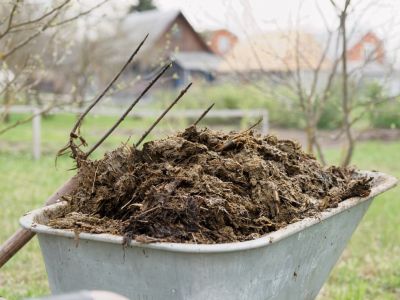There are many ways to keep plants protected from cold, but to actively encourage growth they need consistent warmth. The soil that contacts roots should ideally be around 60 degrees F. (16 C.) for good growth in most plant varieties. Using manure to heat a greenhouse or garden frame is an inexpensive and easy way to apply heat to the roots. Hot bed compost made from manure takes the right amount of carbon mixed into the manure to generate heat.
About Manure Heated Plant Houses
If you have ever been to a cattle or horse ranch, the piles of manure will visibly radiate heat. An ideally developed pile will maintain a temperature of between 141 and 155 degrees F. (61-68 C.) for a week or longer. When combined with carbon matter and covered with soil, the heating effect lasts even longer as the manure decomposes and generates warmth. The microbes that break down the matter release energy in the form of heat. The many microscopic life forms that decompose the manure are more active when the pile is kept moist. Turning the pile further enhances their activity, radiating heat anew. Since turning the pile is not reasonable in a greenhouse or frame situation, the initial heat is mostly to enhance germination. The resulting decomposed manure adds nutrients to the soil, but the heat is not persistent during the plant’s mature growth.
Basic Manure Heating System
Building a pit hotbed is the easiest way to harness the manure’s energy. Dig a pit the desired size, 24 inches (61 cm.) deep. Layer around 4 to 6 inches (10-15 cm.) of rough gravel. This will increase drainage and aeration. Then fill the pit with a mixture of manure and 10 percent straw to a depth of 12 inches (31 cm.). Moisten this layer and tamp it down evenly. Over this layer, lay 4 inches (10 cm.) of nutrient rich, weed free soil. The bed will heat up slowly. Use a soil thermometer to watch for the temperature to drop to 75 degrees F. (24 C.). This is cool enough to plant but warm enough to encourage germination. If you wish, place boards around the pile and bank up the sides with manure to further contain the heat.
Building a Hot Bed
The first step is to build a box or frame. This may be done with wood, bales of straw, cinder blocks, or other materials. You may choose to place a layer of gravel if the base soil is not well draining. Once the structure is complete, level, and sturdy, lay in a mixture of composting manure and straw, horse bedding, or any other carbon matter. Cover the whole thing in landscape fabric or other porous, breathable material. Wait about 10 days before planting to allow ammonia gases produced by the hot manure to dissipate. These can burn plant roots. After planting, cover the structure at night with fabric or greenhouse fabric to contain the heat. Remove it during the day to allow for transpiration of plants and prevent excess moisture build up.
